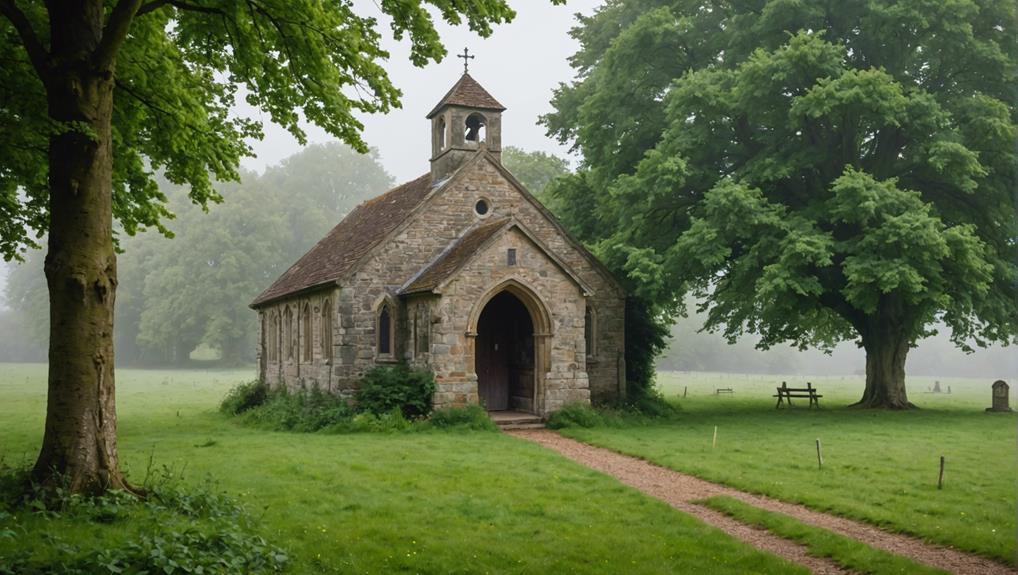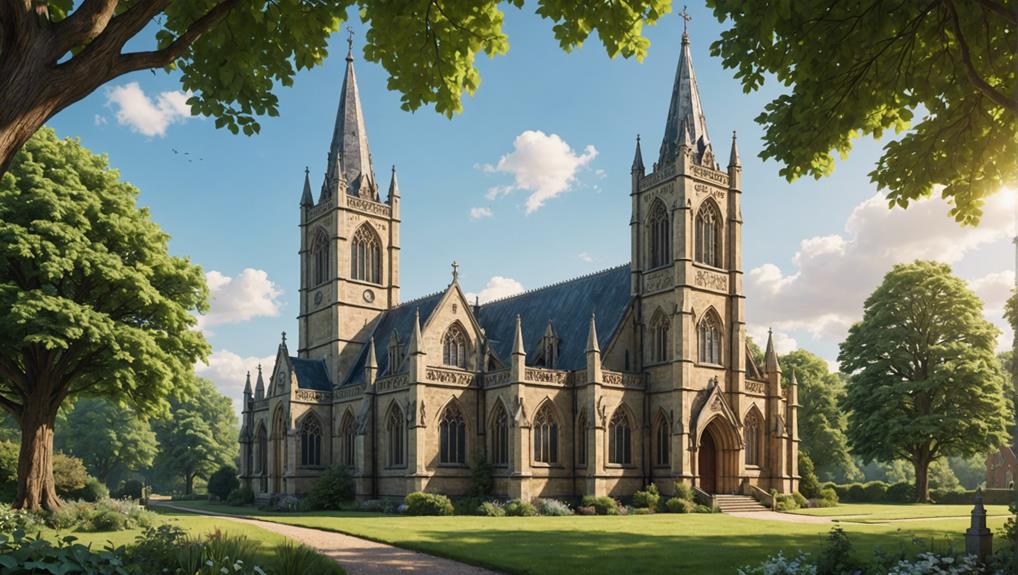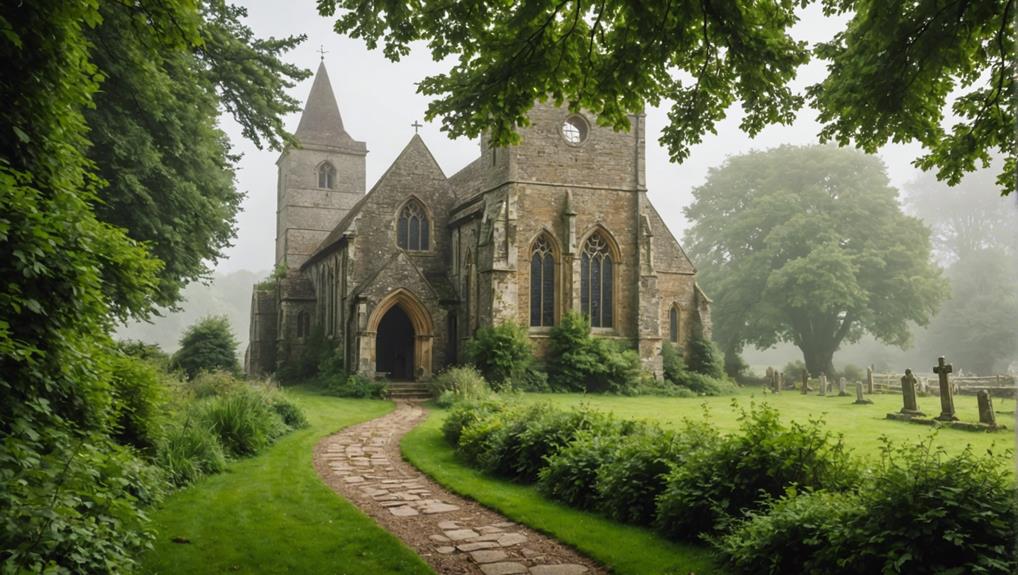The bustling town of Aylesbury is bracing itself for significant travel disruptions as a crucial thoroughfare into the town is […]
As you explore Buckinghamshire, you'll uncover a rich collection of historical religious edifices. Medieval marvels like Princes Risborough's 12th-century church showcase intricate architectural details, while Notley Abbey and Burnham Abbey highlight medieval religious architecture and monastic life. Saxon roots are evident in St. Lawrence in Broughton and Chetwode's St. Mary & St. Nicholas Church. From Gothic architecture to Renaissance-era landmarks, you'll find a wealth of historical significance and tranquility in rural chapels like St. Lawrence, Cholesbury, and Clifton Reynes St. Mary's Church. As you venture further, you'll uncover even more hidden gems, each one revealing a unique piece of Buckinghamshire's storied past.
Key Takeaways
• Buckinghamshire's medieval churches showcase a mix of Norman, Gothic, and Renaissance styles, highlighting the region's rich religious heritage.
• Notley Abbey and Burnham Abbey are significant monastic sites, revealing Buckinghamshire's religious heritage and providing tranquility for spiritual retreats.
• St. Lawrence in Broughton and Chetwode's St. Mary & St. Nicholas Church reflect Saxon religious foundations, blending Saxon and Norman styles.
• The Reformation influenced significant shifts in Buckinghamshire's religious landscape, evident in notable religious buildings like Burnham Abbey and St. Lawrence Church.
• Rural chapels like St. Lawrence, Cholesbury, and Clifton Reynes St. Mary's Church offer tranquil settings for contemplation, steeped in history, art, and spirituality.
Medieval Marvels of Buckinghamshire
As you investigate Buckinghamshire's medieval landscape, you'll discover a treasure trove of historic religious edifices that whisper secrets of the past. Princes Risborough's 12th-century church is a prime example, boasting intricate architectural details that transport you back in time.
Notley Abbey, a former monastery, showcases medieval religious architecture and historical significance, offering a glimpse into the region's rich cultural heritage.
As you explore further, you'll uncover the remnants of monastic life and medieval religious practices at Burnham Abbey, founded in the 13th century. The mix of Norman, Gothic, and Renaissance architectural styles in Buckinghamshire's medieval churches is a proof of the region's diverse cultural influences.
These remarkable edifices not only reflect the region's historical significance but also provide a unique window into the lives of medieval monks and their religious practices. By investigating these medieval marvels, you'll gain a deeper understanding of Buckinghamshire's rich religious heritage and its enduring cultural identity.
Saxon Roots of Christian Heritage
Delving into Buckinghamshire's Saxon roots reveals a rich tapestry of Christian heritage, where centuries-old churches whisper secrets of the region's early Christian settlers.
As you explore the county, you'll discover the 11th-century church of St. Lawrence in Broughton, a sign of early Christianity's foothold in the region. The Saxon influence is palpable in the religious architecture, particularly in Buckingham Chantry Chapel's stunning Norman doorway. This architectural gem showcases the blending of Saxon and Norman styles, a hallmark of Buckinghamshire's rich heritage.
You'll also find St. Michael's Church in Chenies, featuring the 16th-century Bedford Chapel, which highlights the progression from Saxon to Renaissance architectural styles. As you investigate further, you'll uncover Chetwode's St. Mary & St. Nicholas Church, founded as an Augustinian priory in 1244, exemplifying the enduring legacy of Saxon religious foundations in Buckinghamshire.
Churches of the Middle Ages

You'll uncover a treasure trove of medieval churches in Buckinghamshire, each one a reflection of the region's rich religious heritage. As you explore these historic buildings, you'll be struck by the Gothic splendor that dominates their architecture. From the intricate stonework to the stunning stained-glass windows, every detail speaks to the mystical symbolism that underpinned medieval Christianity.
Take St. Lawrence, Cholesbury, for example, where original wall paintings still adorn the walls, offering a glimpse into the region's artistic and spiritual past. Notley Abbey and Burnham Abbey, meanwhile, stand as evidence to the region's monastic heritage, their crumbling stones whispering tales of a bygone era. Compare these local treasures to grand structures like Fountains Abbey and Westminster Abbey, and you'll appreciate the unique charm of Buckinghamshire's medieval churches.
As you explore further into the history of these buildings, you'll discover how they drew inspiration from Roman basilicas, incorporating naves, aisles, apses, and chancels into their designs.
Reformation and Renaissance Era
During this transformative period, Buckinghamshire's religious landscape underwent a profound shift, as the Reformation's tumultuous waves crashed against the shores of traditional faith, reshaping the architectural styles and religious practices of its historic edifices.
You'll notice a significant artistic evolution in the notable religious buildings of this era, such as Burnham Abbey and St. Lawrence Church in Cholesbury. The Reformation brought about a series of religious changes, marked by the dissolution of monasteries and shifts in religious affiliations. This, in turn, influenced the architectural styles of the time, with Renaissance influences introducing more ornate and decorative elements.
As you explore these historic edifices, you'll witness the transformation in religious beliefs and architectural styles. The Reformation's impact on Buckinghamshire's religious landscape is evident in the shifts in religious practices and the evolution of artistic styles. The era's notable religious buildings reflect this transformation, showcasing the blending of traditional and Renaissance influences.
Quiet Reflections in Rural Chapels

Tucked away in Buckinghamshire's rolling countryside, serene rural chapels like St. Lawrence, Cholesbury, await your discovery, offering a peaceful retreat from the hustle and bustle of daily life. These hidden gems aren't only steeped in history but also boast artistic treasures that will leave you in awe.
As you explore these spiritual retreats, you'll uncover:
- Original wall paintings at St. Lawrence, Cholesbury, and Broughton St. Lawrence Church, showcasing the region's rich artistic heritage.
- The tranquil atmosphere of Chetwode's St. Mary & St. Nicholas church, founded as an Augustinian priory in 1244, perfect for quiet contemplation.
- The beautifully preserved 14th-century wooden effigies at Clifton Reynes St. Mary's Church, ideal for a moment of quiet reflection.
In these rural chapels, you'll find a sense of calm, allowing you to step back from the chaos of daily life and reconnect with your inner self. Buckinghamshire's rural chapels are a treasure trove of history, art, and spirituality, waiting to be discovered.
Georgian Architecture of Faith
As you venture into Buckinghamshire's Georgian churches, the elegant symmetry and classical proportions of St. Mary's Church in Amersham and All Saints Church in High Wycombe will strike you, showcasing the refined architectural tastes of the 18th and early 19th centuries.
These notable examples of Georgian architecture in Buckinghamshire's religious buildings embody the era's emphasis on balance, order, and classical motifs. You'll notice the exterior stucco, sash windows, pediments, and porticos, all characteristic of the period.
The influence of prominent architects like Sir John Soane and James Wyatt is evident in the region's Georgian churches, which demonstrate a shift towards simpler, more refined designs. The Georgian elegance of these buildings is undeniable, with architectural symmetry that creates a sense of harmony and calm.
As you explore these beautiful churches, you'll appreciate the attention to detail and the historical significance of Buckinghamshire's Georgian architecture of faith.
Victorian Era Church Restorations

Venturing into Buckinghamshire's historic churches, you'll discover that Victorian era restorations breathed new life into the region's Gothic architecture, preserving and enhancing the original structures while infusing them with vibrant stained glass, ornate decorations, and improved interior design.
These restoration projects, influenced by prominent architects like Sir George Gilbert Scott and Augustus Pugin, aimed to address structural issues, repair damage, and revive historical elements of the churches. The result was a harmonious blend of Gothic revival and architectural preservation.
Some notable aspects of these restorations include:
- The addition of stunning stained glass windows, which filtered in kaleidoscopic colors and bathed the interiors in a warm, ethereal glow.
- The incorporation of decorative features, such as intricate carvings and ornate tile work, which added depth and visual interest to the spaces.
- The improvement of interior design, which created a sense of warmth and welcoming comfort for worshippers.
These Victorian era church restorations played an important role in maintaining the religious and architectural heritage of Buckinghamshire, ensuring that these magnificent structures would continue to inspire and uplift generations to come.
20th Century Sacred Landmarks
Beyond the Victorian era restorations, you'll find a new wave of sacred landmarks in Buckinghamshire, showcasing 19th-century architectural innovations and stylistic flourishes that continue to inspire.
As you explore the county, you'll discover a plethora of remarkable churches that epitomize the era's architectural splendor. Take St. Michael and All Angels Church in Hughenden, for instance, which boasts stunning Victorian Gothic architecture.
Marlow Methodist Church, built in the 19th century, is another standout, featuring a striking red brick exterior and intricate stained glass windows. The Church of St. Mary the Virgin in Denham is yet another significant 19th-century religious site, boasting a prominent spire and elegant interior decorations.
St. Peter and St. Paul's Church in Great Missenden and Holy Trinity Church in Penn are also notable examples of 19th-century innovations, blending Gothic and Victorian elements with picturesque settings.
These landmarks not only demonstrate the era's architectural prowess but also offer a glimpse into Buckinghamshire's rich religious heritage.
Hidden Gems of Buckinghamshire

Tucked away in Buckinghamshire's rolling hills and picturesque villages, you'll discover hidden gems like Notley Abbey and Burnham Abbey, two monastic sites that whisper secrets of the county's rich religious heritage.
As you explore these historic sites, you'll uncover the fascinating story of monastic life in Buckinghamshire.
Experience the tranquility of these sacred spaces, perfect for a spiritual retreat or a moment of quiet contemplation.
Explore the local history of these abbeys, discovering their significance in the region's medieval past.
Imagine the daily life of monks and nuns who once called these abbeys home, and appreciate the stunning architecture that has stood the test of time.
In these hidden gems, you'll find a unique blend of history, architecture, and spirituality.
Whether you're interested in abbey exploration, local history, or simply seeking a peaceful retreat, Notley Abbey and Burnham Abbey are must-visit destinations in Buckinghamshire.
Frequently Asked Questions
What Is Buckinghamshire Known For?
You'll discover that Buckinghamshire is known for its picturesque Chiltern Hills and serene rural landscapes, offering a tranquil escape from urban life, with rolling hills, woodlands, and scenic villages waiting to be explored.
How Old Is Wing Church?
You're curious about Wing Church's age - it dates back to the 12th century, boasting original Norman architecture and preserving its historical character through 19th-century restoration, making it a fascinating piece of Church History.
Conclusion
As you've explored Buckinghamshire's rich heritage, you've uncovered a treasure trove of historical religious edifices. From medieval marvels to 20th-century landmarks, each era has left its mark on the county's sacred landscape.
With Saxon roots, Georgian elegance, and Victorian restorations, these remarkable structures stand as evidence to the region's enduring faith and architectural innovation.